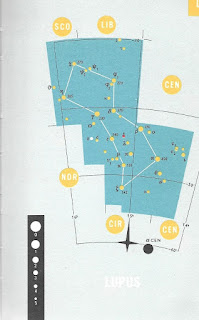Orion the Hunter
Without
doubt the brightest and grandest constellation in the sky, crammed
with objects of interest for all sizes on instruments. Orion’s
impressiveness stems from the fact that it is an area of star
formation in a nearby arm of the galaxy, centred on the famous Orion
Nebula.
The
Orion Nebula M42 marks the hunter’s sword hanging from his belt.
The belt itself is formed by a line of three bright stars. Orion is
depicted as brandishing a club and shield at the snorting Taurus the
Bull.
In
one story the boastful Orion was stung to death by a scorpion and is
now placed in the sky so he sets as the scorpion rises.
Each
year the Orionid meteor shower radiates from a point near the
boundary near Gemini. Around 20 meteors per hour may be seen around
October 21st
Alpha
Betelgeuse which means the Underarm of Orion is the 9th
brightest star in the sky. It varies in brightness between 0.4-1.3
these variations were first reported in 1836 by John Herschel. When
at its faintest it is decidedly fainter than Rigel. During the winter
of 2019-2020 Betelgeuse became very faint causing astronomers to
wonder if it was in the process of going supernova. The star has in
fact been as faint as this before in 1927. It is a red giant star
entering its final phase and will probably go supernova within the
next 1 million years.
It is 642 light years away and is a M1 class supergiant with a
temperature of around 3,300’ C.
Beta
or Rigel which means the left foot is the 7th
brightest star in the sky at mag 0.1. It is 863 light years away, sp
B8 Ia and like Betelgeux will end up going supernova, temp 12,000
degrees.
Gamma
or Bellatrix which means the conqueror or Amazon star is the 3rd
brightest star in Orion. It has a magnitude of 1.6, and lies at a
distance of 250 light years. It is a B2 giant with a temperature of
21,500 degrees.
Zeta
or Alnitak which means the Girdle is the left hand star of the belt.
Alnitak has a magnitude of 2.0 and is 1200 light years distant. It
is one of the rare 09 class supergiants with a temperature of
29,000’C. Alnitak will become a supernova in the future
Epsilon
or Alnilam which means string of pearls at magnitude 1.6 is the 4th
brightest star in Orion. Alnilam is the middle star of the belt. Its
distance is about 2,000 light years, and is a B0 class supergiant
with a temperature of 27,000’C.
Delta
or Mintaka the right hand star of the belt its name means the belt,
its magnitude is 2.2 and lies 1200 light years away, another of the
rare 0.9 class stars with a temperature of 29,000’C, and as with
Alnitak, Mintake will become a supernova.
Theta
(one) is known as The Trapezium or Orion Trapezium Cluster is a
cluster of 4 stars in the heart of the Orion Nebula they were first
seen by Galileo in 1617 but he only saw 3 of the stars the fourth was
discovered by several observers in 1673. The 4 stars are within 1.5
light years of each other and are responsible for much of the
illumination of the surrounding nebula. The Trapezium may be a
sub-component of the larger Orion Nebula Cluster, a grouping of about
2,000 stars within a diameter of 20 light-years. They have
magnitudes of 5.1,6.7, 6.7 and 8.0.
Kappa
or Saiph which means sword of the giant is of magnitude 2.1 and lies
650 light years away, it is a B0 class star with a temperature of
26,000’C.
Iota
or Na’ir al Saif, which means "the Bright One of the Sword is
the brightest star in the asterism known as the sword of Orion,
Magnitude 2.8 and lying at a distance of 2,300 light years. Like
many of the stars in Orion it is one of the rare 0.9 giant stars
with a temperature of 32,000’C. Again iota will become a supernova
in the future.
Messier
42/43
One
of the great mysteries in visual astronomy is that Galileo apparently
never noticed the great nebula in Orion. There also appears to be no
record of it in medieval records either. Yet here is one of the
grandest naked eye nebulae in the heavens just below the famous Orion
belt stars. It could not possibly have been missed by Galileo and is
especially puzzling. It is also interesting that the Arab astronomers
including Al Sufi had recorded the much fainter nebula in Andromeda
M31, the first mention in western records is around 1615.
A stellar nursery, The Orion nebula is an enormous cloud of gas about
40 light years in diameter. The cloud is illuminated by a group of
four stars known as the Trapezium, these four jewels are between
magnitude 5 to 8, all the stars which are very young being about 1
million years old and there are thousands of unseen stars between
300,000 to 1 million years old. The nebula is about 1600 light years
away.
M43
is a separate nebula often overlooked because of its close proximity
to the Great Orion Nebula, it is separated from M42 by a dark lane of
gas known as the Fish Mouth. M43 surrounds a 7th magnitude star known
as Bond,s star. To see M43 you have to obscure the light from M42 a
good way of seeing M43 is just to gently tap the telescope tube and
that slight rocking will allow you to see M43. One very well known
astronomer discovered this trick while looking at the nebula when a
small earthquake occurred causing the telescope to vibrate slightly.
M78
A
diffuse nebula of the 9th
magnitude above and to the right of Alnitak
NGC
1977
Is
an elongated nebulosity jusy north of the Orion nebula centred on the
5th
mag star 42 Orionis. The object would be more celebrated if it were
not overshadowed by M42.
NGC
2024
A glowing area of gas about 0.5 degrees wide
surrounding the star zeta of Alnitak. Running south from Alnitak is a
strip of nebulosity into which is indented the Horsehead Nebula, a
dark cloud of obscuring dust shaped like a horse’s head. Although
you will see the picture in many books it is notoriously difficult to
see with the eye through amateur telescopes.
The
Barnard Loop is the remains of a supernova that exploded about 2
million year ago. It was first photographed by Edward Barnard in
1883, it can be seen with the eye under the best of conditions. There
are suggestions that it was seen
by the Vikings over 1,000 years ago.




































